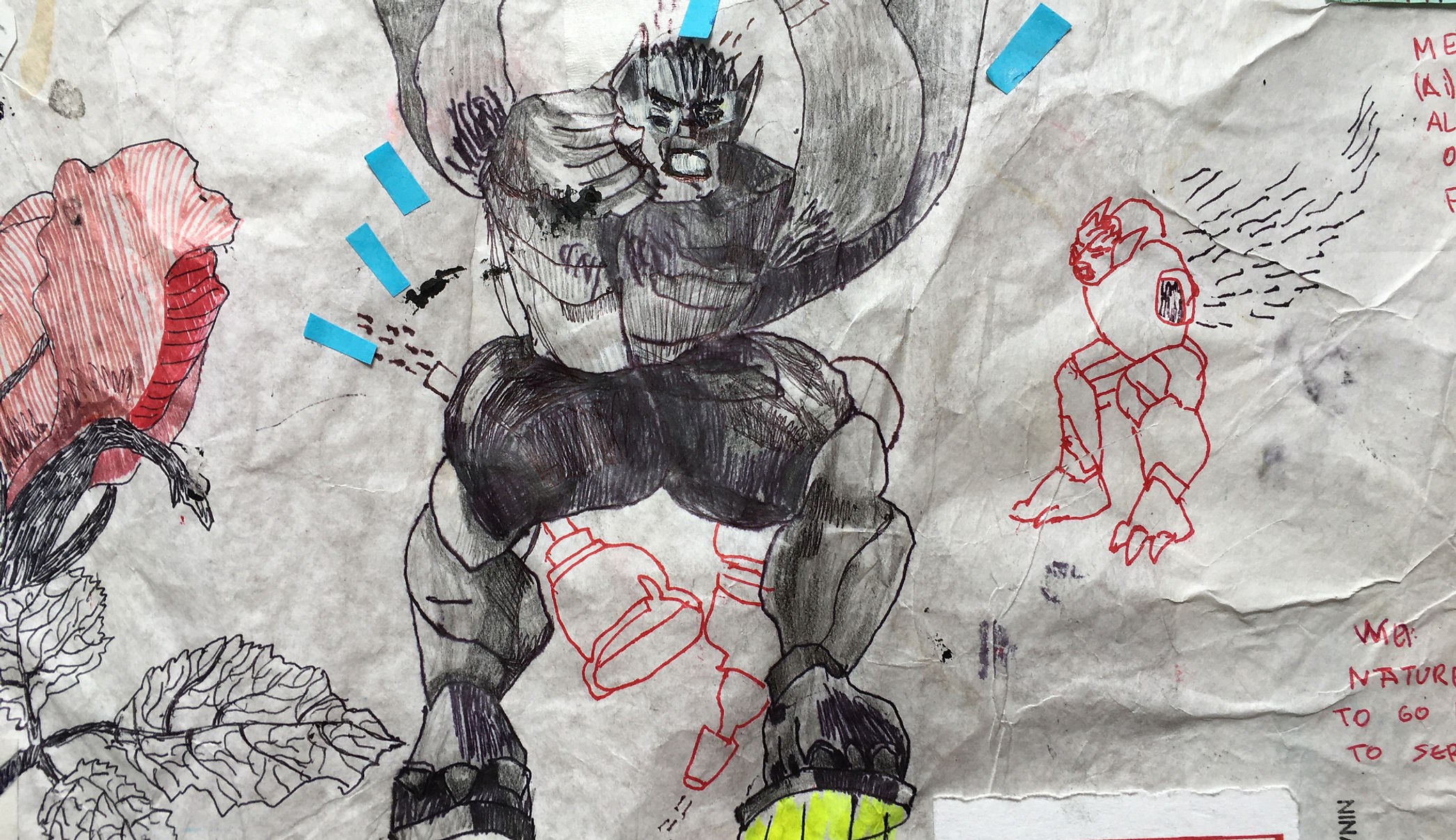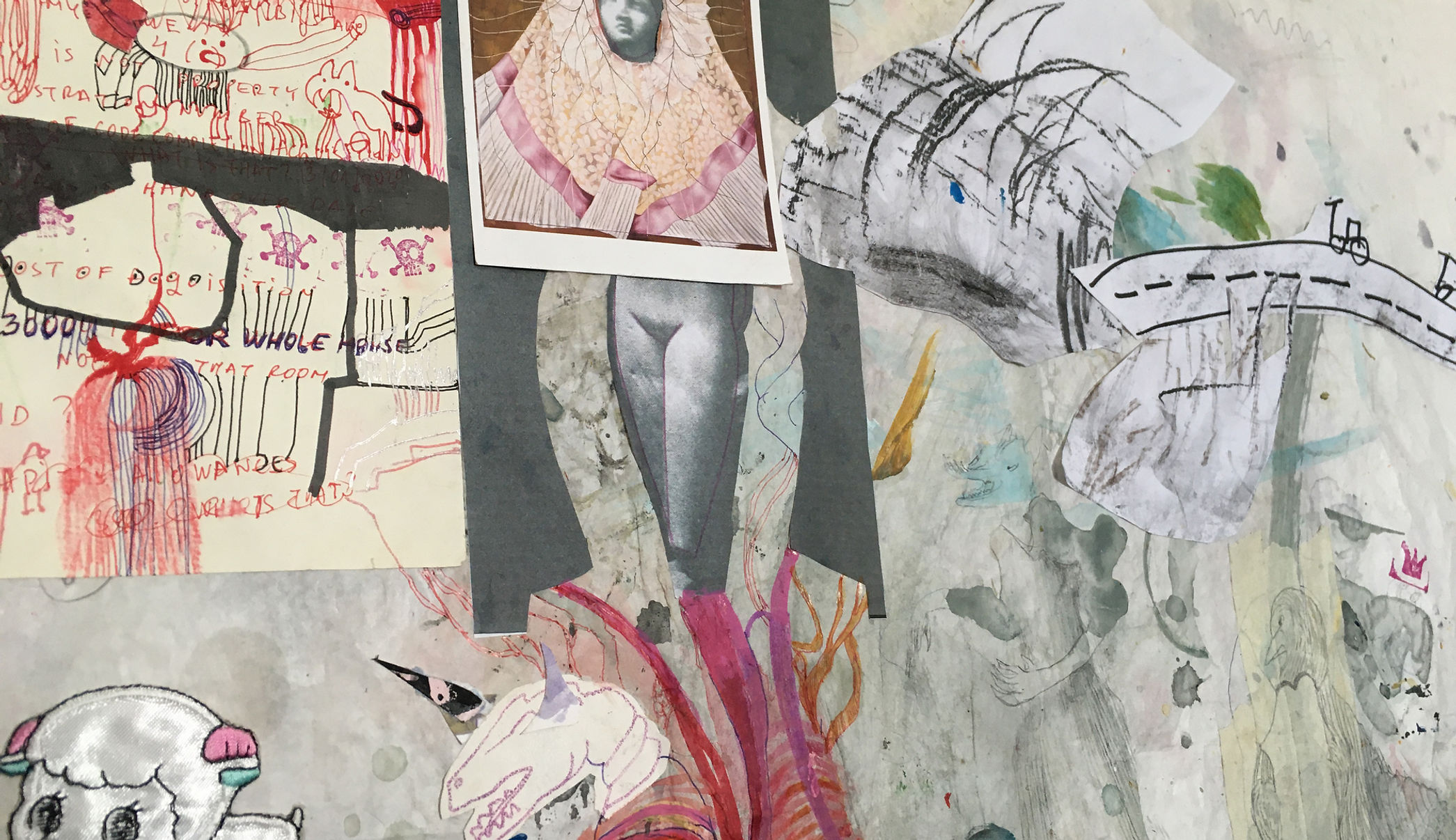
This new series of drawings emerged during my residency at Schafhof – European Art Forum in the spring of 2024. They developed while I was working on another project titled DATA mattering, almost as a subproduct—quietly forming in the background, like sediment collecting over time. Initially they began as underpapers—thin, nearly invisible sheets beneath my working surface that unintentionally gathered marks, fragments, and traces. But over time, they transformed into an active, vital method of working in their own right.
These drawings process personal impressions, emotional residues, and fragments of memory that arise in the course of other creative labor. They function as a parallel system of release, reflection, and registration. The process is the product: there is no final goal beyond the act of transcribing the inner movement of thought—automatically, intuitively, raw.
Each drawing maps the mind in motion, capturing traces of what is often left unrecorded. There is no deliberate composition, only the accumulation of moments—some accidental, some obsessive, some poetic. From the political to the intimate, from confession to resistance, these works speak in layers, through interruptions, rhythms, and silences. The paper, delicate and prone to tearing, mirrors the fragility of experience and memory itself.
They remain suspended between visibility and secrecy, gesture and symbol, echoing Kant’s idea of schematism—the bridge between perception and concept—and Bergson’s duration, time experienced as a flow rather than a count. The work also resonates with Deleuze’s notion of art as event: something that happens rather than represents.
These pieces were deeply shaped by their context. The architectural rhythms of Schafhof, the threshold-like quality of the space, and the entrance work by Csongor G. Szigeti influenced my awareness of transitional zones—mental and physical. The poetic resonance of P. Shirley’s book title further illuminated the idea of drawing as a means of collecting what resists articulation, of recording what remains rather than what announces itself.
In spirit, this series is also in quiet dialogue with artists like Hanne Darboven and Chantal Akerman, where repetition, time, and notating the everyday become acts of resistance and devotion. These drawings are not preparatory sketches but cognitive topographies—visual recordings of thinking, sensing, and remembering. They unfold in between spaces: between artworks, between thoughts, between states of knowing and unknowing.
They are not so much about making meaning as about noticing what slips through meaning’s frame. Fragile, processual, and persistent, they reveal that the act of drawing can itself be a form of living thought.
My current drawing series explores perception, memory, and the overflow of unprocessed information we encounter daily. These works are not classical drawings in the traditional sense—they emerge from what is left over, drawn over, or never fully understood. Each drawing captures a residue, a trace of data or emotion that passes through the body before it becomes a thought. They are observational tools for mapping the observer's own mental landscape.
Drawing becomes a method of observing the observer, of catching what lingers in the nervous system before it is filtered, categorised, or rationalised. They are maps of caught data—like handwritten neural nets, poetic glitches, notes of confusion, memory fragments, and filtered noise from media narratives, scrolling, dreams, conversations. They trace the moment before meaning.
This practice is rooted in my interest in perception, cognition, and the influence of media-imposed narratives. How are we trained to see? What is remembered? What is filtered out? In an age of AI-assisted simplifications and dopamine-driven interfaces, these drawings resist easy understanding. They challenge the passive consumption of data by slowing down the process and reactivating observation and thought.
Šumarac’s broader body of work also includes video, installation, and a critical approach to AI—often reflecting on the way data, language, and technology interface with memory and social structures. Although drawing is currently my main medium, I do not limit myself to any specific form. The conceptual core of each project defines the medium—whether media art, painting, installation, or hybrid formats. The process is the product.
Whether intimate or research-driven, my works often respond to urgent socio-political realities, misinformation, or the boundaries between what we know and what we assume. I'm interested in fragility and contradiction—especially in the space between internal experience and the external world.
Title (optional working title): Datta Mattering
(or: "Observing the Observer" or "Process is a product)
Proposal Draft:
Drawing becomes a method of observing the observer – a practice of registering what lingers in the body and brain before thought solidifies into concept. It is not about representation but about perception: a residue, a trace, a moment when something touches the nervous system before words appear.
At the beginning of the project, drawing will be the primary medium. Through drawing, I explore the tension between internalised impressions and the external stimuli that shape them, from news fragments, sudden thoughts, memories, digital debris, or emotional residue. Each drawing becomes a map of a specific time, a visual note responding to the continuous stream of information we receive daily.
Narration, in this process, becomes a form of data storage – not linear, not fixed, but one of infinite potential arrangements. I am interested in how narratives are imposed by media structures, how we are trained to perceive and behave through curated data, and how the seductive ease of AI-generated responses can dull our critical capacities. My project addresses the increasingly blurred lines between lived reality and mediated perception, between our unique inner voices and collective informational noise.
This proposal builds upon my previous project Data Geo-Matter-ing, which investigated the friction between data saturation and personal cognition. In it, I posed the question: if AI and algorithms are trained on our digital traces, what are we trained on?
Referencing thinkers such as Nicholas Carr (The Shallows) and T.S. Eliot (The Waste Land), I position my drawings as responses to what gets filtered, remembered, or suppressed in the body-mind system amidst digital overload. I consider:
– What do I actually retain in a world of endless updates?
– What resonates naturally, and what is being imposed?
– What do I wish to unlearn?
– Can I still identify my own voice in this age of recombinant information and synthetic creativity?
The project is informed by a metaphor of the brain as an organic computer, a biological processor of spoken, visual, and sensory data filtered through education, DNA, imagination, and daily training. Prompts – whether verbal, visual, or emotional – shape our perception just as they shape machine learning models.
In this context, drawing becomes a resistive act. It allows for slowness, ambiguity, and imperfection – qualities often absent in algorithmic systems. It also becomes a means of recording a kind of inner newsfeed: what surfaces, what sticks, what forms new connections. Over time, these drawings may evolve into a larger visual system, a nonlinear archive, or even a speculative predictive program.
In a reality increasingly mediated by AI, I ask: how can artists retain agency without resisting new tools? How can we collaborate with technology without becoming servants to its patterns? And how do we document our fleeting inner constellations in a world where everything is designed to be seen, but very little is truly noticed?




























